Inchoate Instruments may sound complex, but they’re actually quite simple to understand. In this guide, we’ll explore what inchoate instruments are, how they work, and provide examples to illustrate their concept.
Table of Contents
Understanding Inchoate Instruments
An inchoate instrument is a legal term that refers to a document or contract that is incomplete or not fully executed. Essentially, it’s a document that hasn’t been fully formed or finalized yet. Despite its incomplete nature, an inchoate instrument still holds significance as it represents an agreement or obligation between parties that may be legally binding once fully executed.
Key Points:
- Incomplete Document: An inchoate instrument is a document or contract that lacks certain essential elements required for it to be considered fully executed or enforceable.
- Potential Legal Obligations: Despite being incomplete, an inchoate instrument may still create legal obligations or rights between parties once it’s fully executed or finalized.
- Requirements for Validity: To become fully enforceable, an inchoate instrument typically requires the completion of missing elements, such as signatures or terms, as specified by applicable laws or regulations.
How Inchoate Instruments Work
- Creation: Inchoate instruments are often created during the negotiation or drafting stage of a contract or agreement. They may contain placeholders for missing information, such as blank spaces for signatures, dates, or terms.
- Intention to Create Legal Relations: Even though an inchoate instrument is incomplete, it still reflects the parties’ intention to enter into a legally binding agreement. It serves as evidence of their agreement to be bound by certain terms once the document is finalized.
- Finalization: Once all necessary elements are filled in and the document is fully executed according to legal requirements, the inchoate instrument becomes a fully enforceable contract or agreement.
Example of Inchoate Instrument
Let’s consider an example of an inchoate instrument in the context of a real estate transaction:
- Purchase Agreement: Suppose Buyer A and Seller B are negotiating the sale of a house. They draft a purchase agreement outlining the terms and conditions of the sale, including the purchase price, closing date, and conditions for inspection.
- Incomplete Document: Initially, the purchase agreement is incomplete because it lacks Buyer A’s signature and the agreed-upon closing date. However, Seller B signs the agreement, indicating their intention to sell the property under the specified terms.
- Finalization: After Buyer A signs the agreement and the closing date is determined, the purchase agreement becomes fully executed and legally binding. Both parties are now obligated to fulfill their respective responsibilities as outlined in the agreement.
Conclusion
Inchoate instruments are essential legal concepts that represent agreements or contracts in their early stages before they’re fully executed. Despite being incomplete, inchoate instruments still hold significance as they reflect the parties’ intentions and may create legal obligations once finalized. Understanding inchoate instruments is crucial for navigating various legal transactions and agreements in business and finance.





